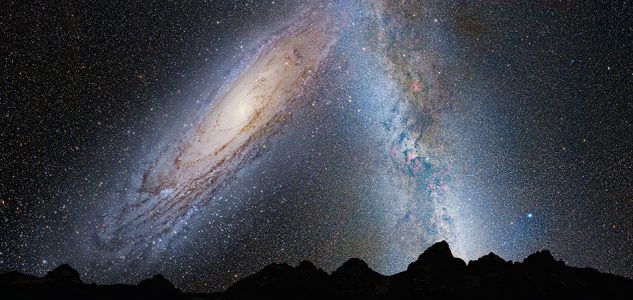Scientists close in on the true mass of the Milky Way by calculating what they know, what they partially know and what is still uncertain

BY Wade Hemsworth
January 7, 2017
It’s a problem of galactic complexity, but researchers are getting closer to accurately measuring the mass of the Milky Way Galaxy.
In the latest of a series of papers that could have broader implications for the field of astronomy, McMaster astrophysicist Gwendolyn Eadie, working with her PhD supervisor William Harris and with a Queen’s University statistician, Aaron Springford, has refined Eadie and Harris’s own method for measuring the mass of the galaxy that is home to our solar system.
The short answer, using the refined method, is between 4.0 X 1011 and 5.8 X 1011 solar masses. In simpler terms, that’s about the mass of our Sun, multiplied by 400 to 580 billion. The Sun, for the record, has a mass of two nonillion (that’s 2 followed by 30 zeroes) kilograms, or 330,000 times the mass of Earth. This Galactic mass estimate includes matter out to 125 kiloparsecs from the center of the Galaxy (125 kiloparsecs is almost 4 X 1018 kilometers). When the mass estimate is extended out to 300kpc, the mass is approximately 9 X 1011 solar masses.
Measuring the mass of our home galaxy, or any galaxy, is particularly difficult. A galaxy includes not just stars, planets, moons, gases, dust and other objects and material, but also a big helping of dark matter, a mysterious and invisible form of matter that is not yet fully understood and has not been directly detected in the lab. Astronomers and cosmologists, however, can infer the presence of dark matter through its gravitational influence on visible objects.
Eadie, a PhD candidate in Physics and Astronomy at McMaster University, has been studying the mass of the Milky Way and its dark-matter component since she started graduate school. She uses the velocities and positions of globular star clusters that orbit the Milky Way. The orbits of globular clusters are determined by the galaxy’s gravity, which is dictated by its massive dark matter component.
Previously, Eadie had developed a technique for using globular cluster (GCs) velocities, even when the data was incomplete.
The total velocity of a GC must be measured in two directions: one along our line-of-sight, and one across the plane of the sky, called the proper motion. Researchers have not yet measured the proper motions of all the GCs around the Milky Way. Eadie, however, had previously developed a way to use these velocities that are only partially known, in addition to the velocities that are fully known, to estimate the mass of the galaxy.
Now, Eadie has used a statistical method called a hierarchical Bayesian analysis that includes not only complete and incomplete data, but also incorporates measurement uncertainties in an extremely complex but more complete statistical formula. To make the newest calculation, the authors took into account that data are merely measurements of the positions and velocities of the globular clusters and not necessarily the true values. They now treat the true positions and velocities as parameters in the model (which meant adding 572 new parameters to the existing method).
Bayesian statistical methods are not new, but their application to astronomy is still in its early stages, and Eadie believes their capacity to accommodate uncertainty while still producing meaningful results opens many new opportunities in the field.
“As the era of Big Data approaches, I think it is important that we think carefully about the statistical methods we use in data analysis, especially in astronomy, where the data may be incomplete and have varying degrees of uncertainty,” she says.
Bayesian hierarchies have been useful in other fields but are just starting to be applied in astronomy, Eadie explained.
The Astrophysical Journal has accepted the research for publication (it is currently in press), and Eadie is to present the results January 7 at the 229th meeting of the American Astronomical Society in Grapevine, Texas.


